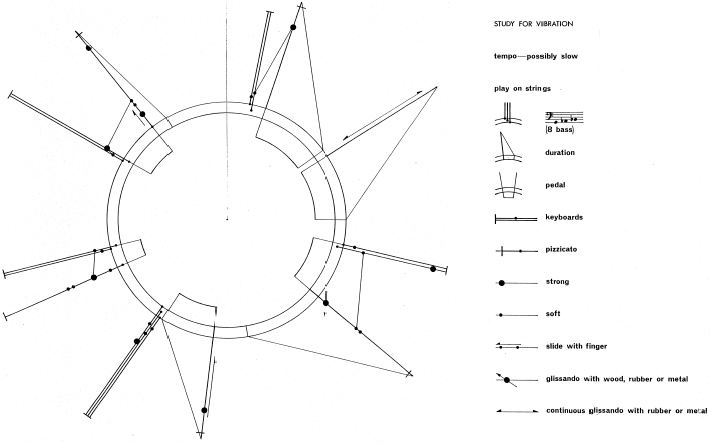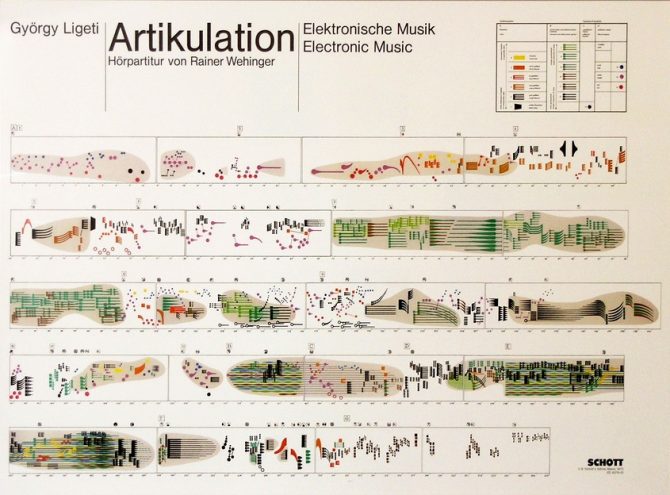About shakuhachi notations
Opening your repertoire
Frédéric Boulanger
frederic.boulanger.fbo@gmail.com
World Shakuhachi Mentoring Day – March 30 2025
About me
Frédéric Boulanger
Professor in Computer Science at Université Paris-Saclay
I play the clarinet and bass clarinet as a hobby
I have developed an interest in the shakuhachi since 2010:
- Began with a DVD by Gunnar Jinmei Linder (first piece was Hi Fu Mi 😅)
- Participated in masterclasses, summer schools, workshops, ...
Now:
- I study the Tozan and KSK styles with Jean-François Lagrost (Shin Tozan ryū)
- I study the Kinko Chikumeisha style with Gunnar Jinmei Linder (Chikumeisha)
- I study Japanese traditional and contemporary ensemble music
with Mieko Miyazaki and Jean-François Lagrost
Shakuhachi notation
Some weird facts for a Western musician
- When beginning the shakuhachi, traditional notation is a surprise
- Then, you discover that there are several traditional notations
- And then, that the notation for koto and shamisen is yet something else
- Maybe you can do without a conductor for ensemble music...
- ... until you discover that you do not even have the same bars!
My goals today
- Show you that handling several notations is not so complex
- Invite you to cross school boundaries:
reading a new notation may not be the difficult part, but it can stop you - Consider Western notation
A brief history of shakuhachi notations
Shakuhachi notation has roots in hitoyogiri notation
Shakuhachi is present in Japan during the Nara period (710-794 CE)
First documented notation system in 1608 in the Tanteki Hiden Fu
(Secret pieces for the short flute)
1664: Shichiku Shoshinshu (Self-help guidebook on musical instruments)
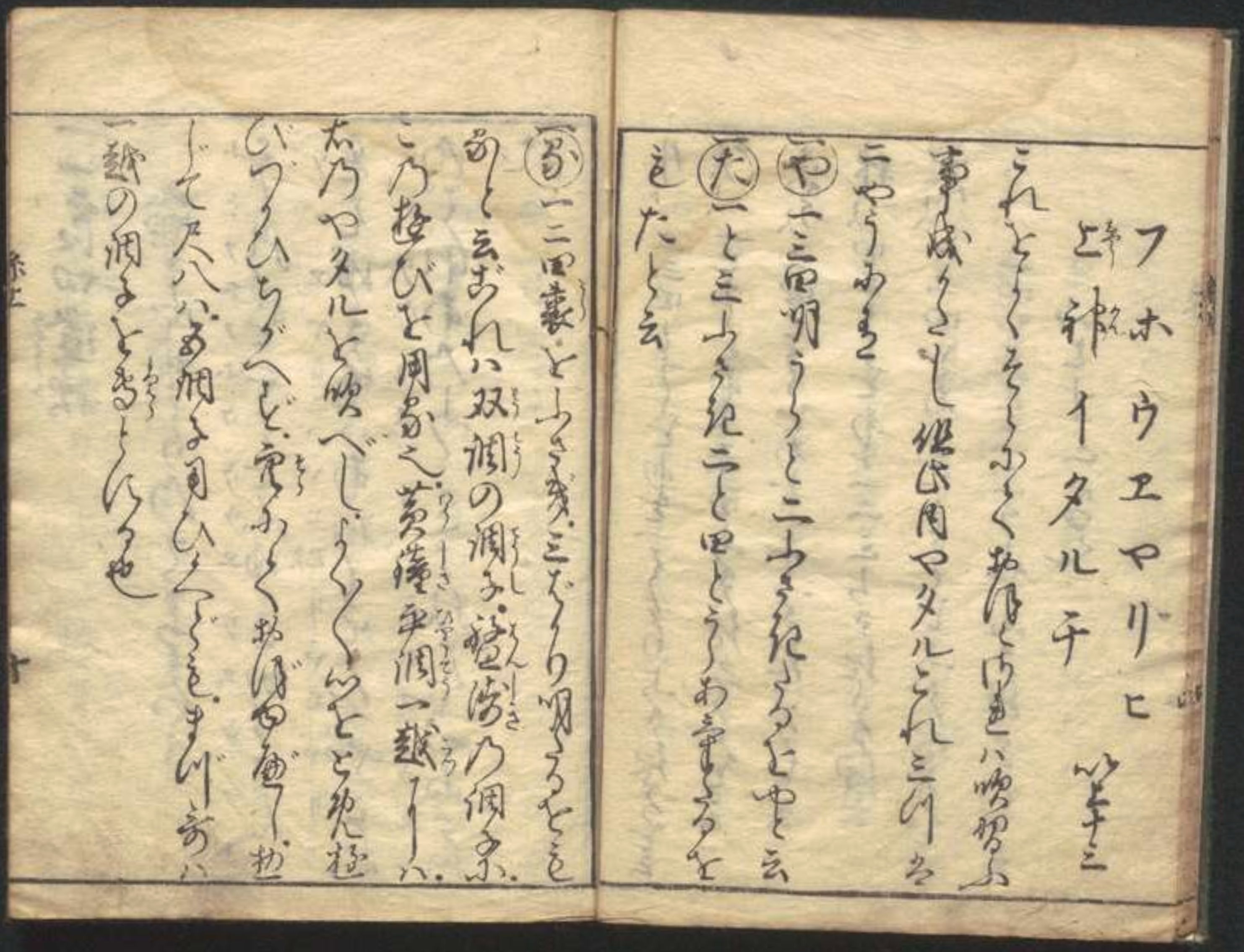

Fu Ho U notations
Hitoyogiri notation with 13 syllables (katakana) representing different notes:
fu フ i イ ya ヤ chi チ ho ホ u ウ e エ
ri リ hi ヒ kan 神 ta タ ru ル shō 上.
Some shakuhachi players changed the hitoyogiri notation and used:
fu フ ho ホ u ウ we ヱ ya ヤ i イ
for the basic fingerings of the shakuhachi
Fu Ho U notations are used in some schools:
- The Kyū Myōan schools such as Kichiku Ryū and Shimpō Ryū
- Chikuho Ryū, although its notation is quite different
Kyū Myōan notation
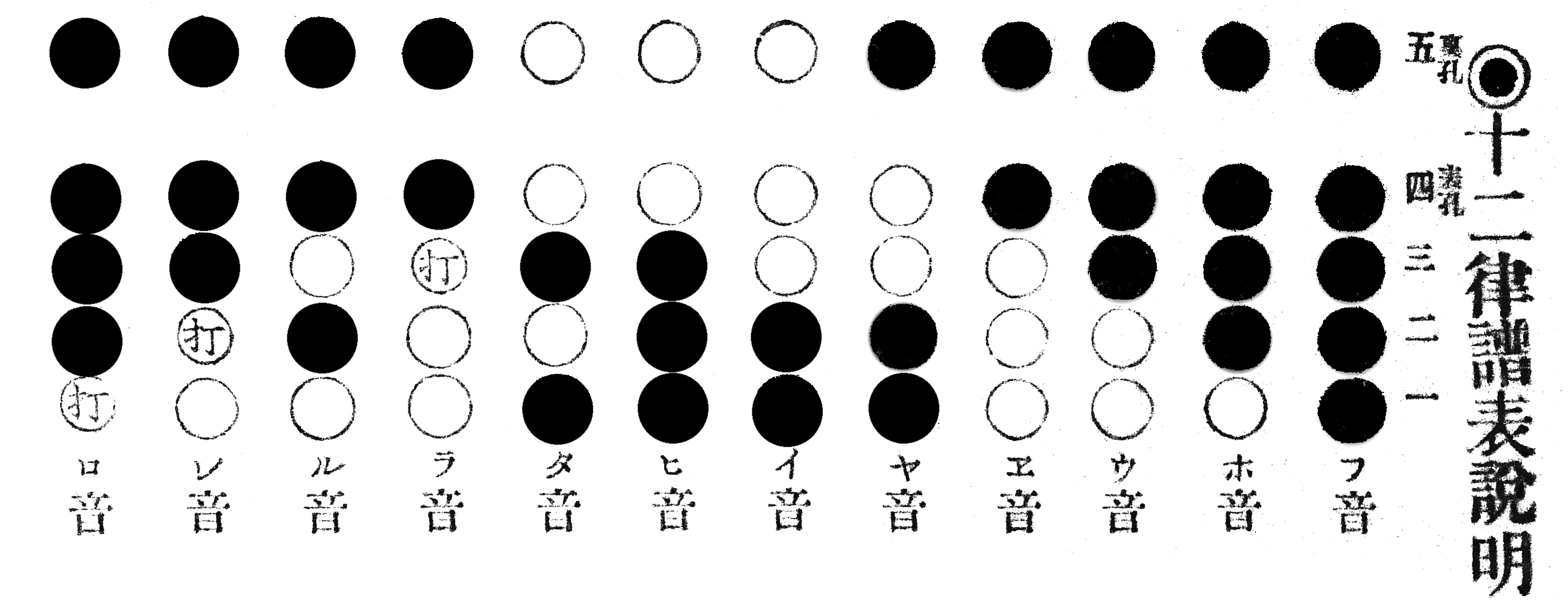
Kyū Myōan fingering chartsource: Justin Senryū
Tehodoki Reiho, Kichiku Ryū - Justin Senryū
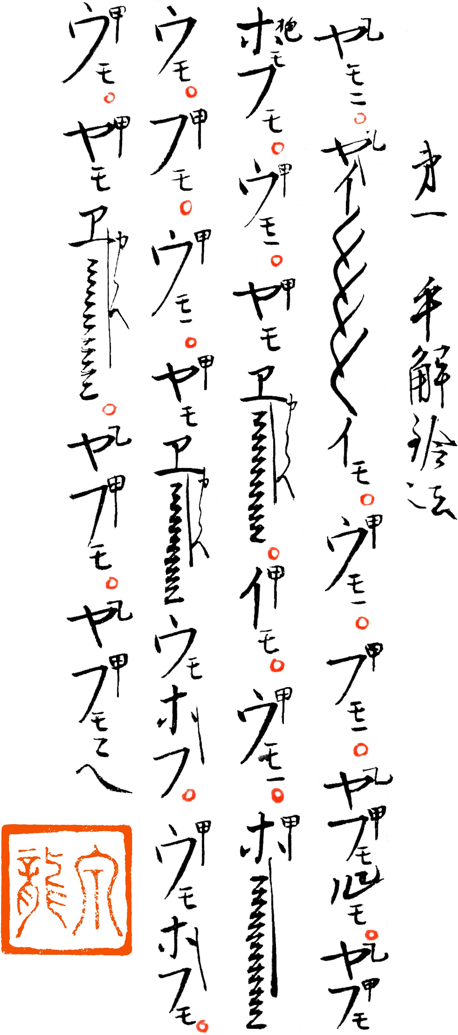
Chikuho Ryū notation
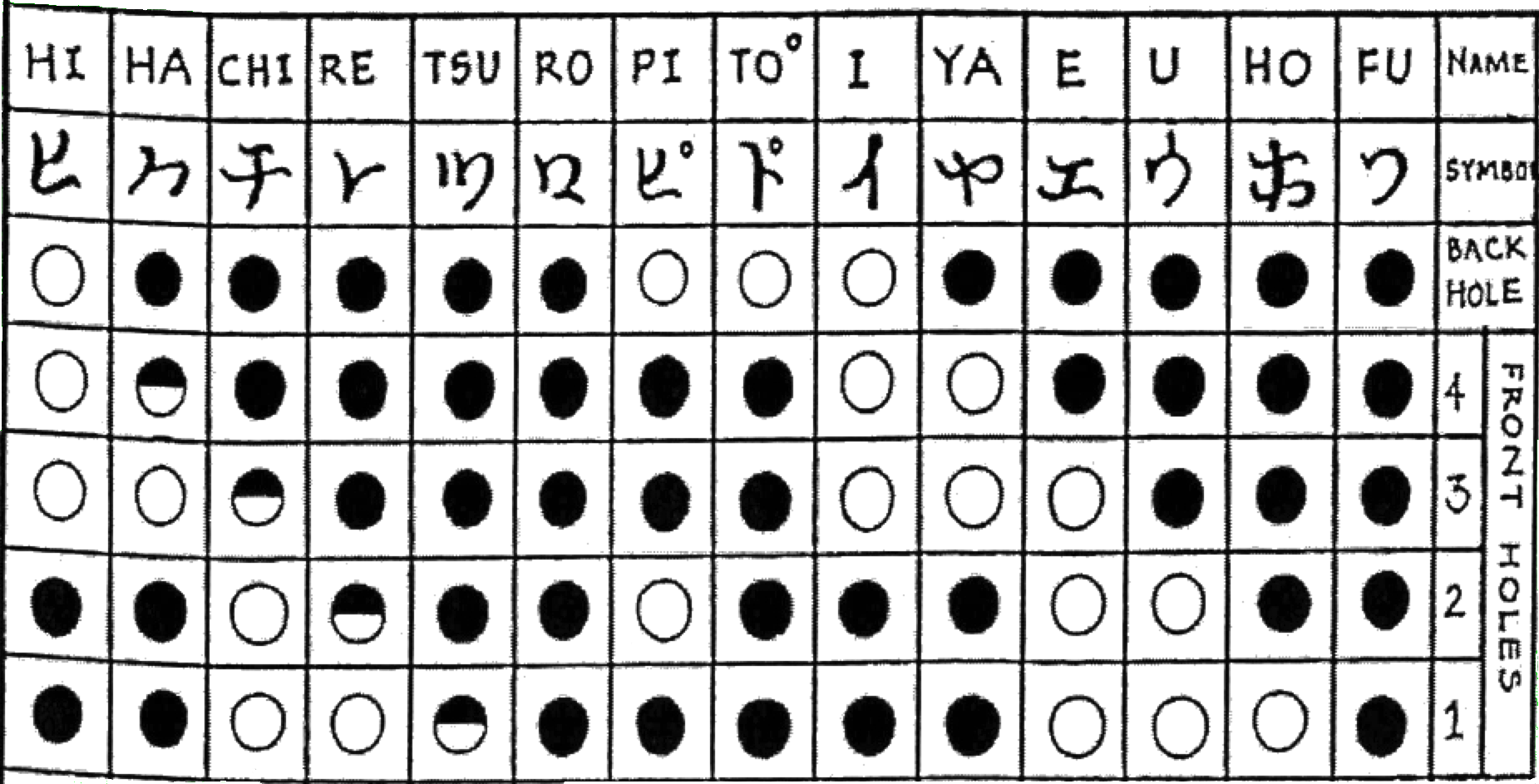
Chikuho Ryū fingering chartsource: Jean-François Lagrost

Ro Tsu Re notations
some players developed a notation that uses the letters
ro ロ tsu ツ re レ
instead offu フ ho ホ u ウ
These Ro Tsu Re notations are now the most prevalent:
- The Kinko notation, initiated by Araki Kodo II
and developed during the XIXth century by Araki Kodo III
+ rythm notation by Uehara Rokushiro and Kawase Junsuke - The Tozan notation, developed by Nakao Tozan
after the Meiji restauration - There are variations around these two main notations
that we may consider as families of notations.
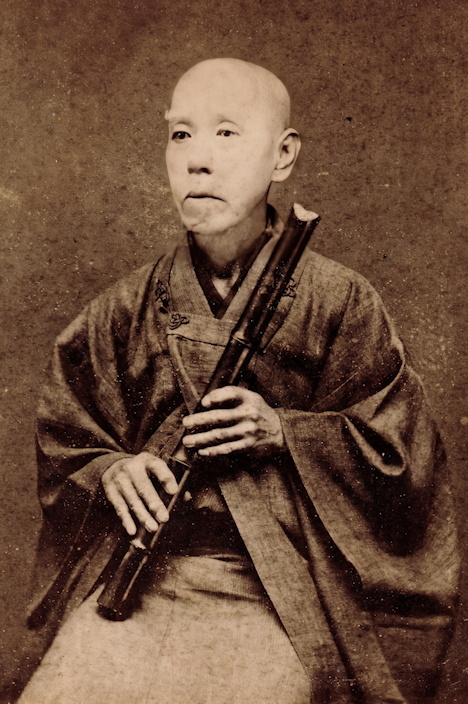
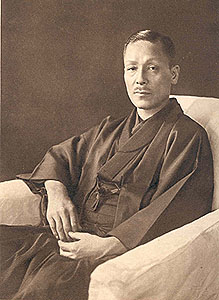
KSK / Chikushin Kai honkyoku notation
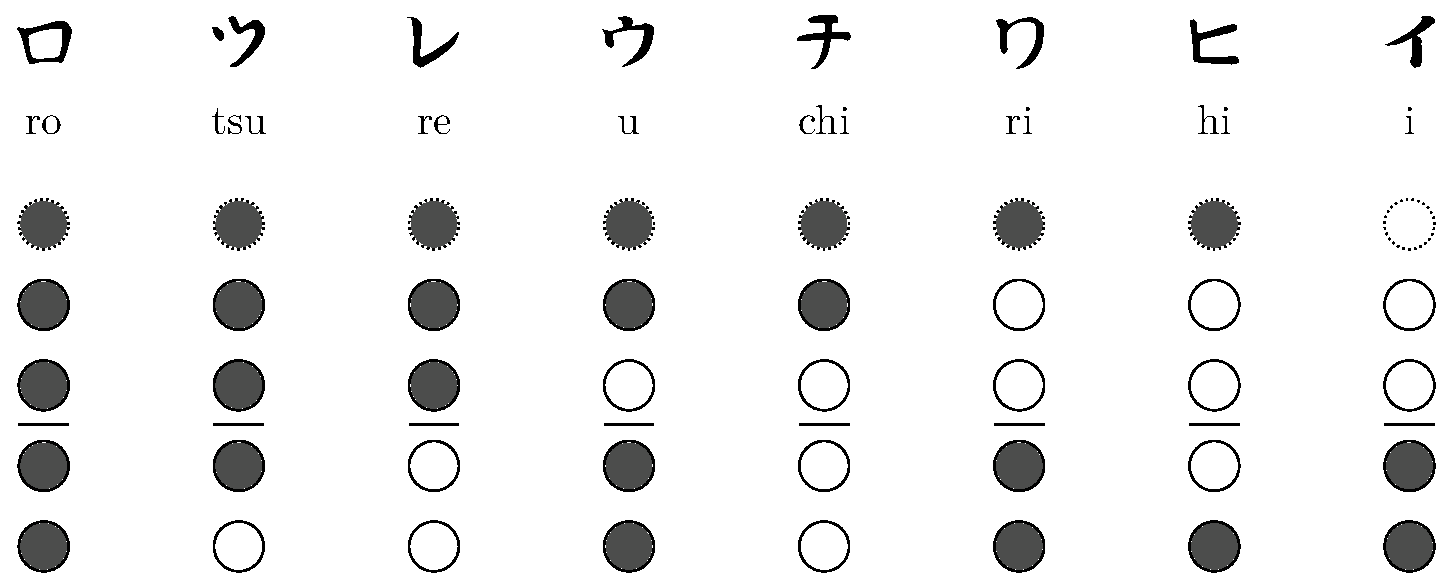
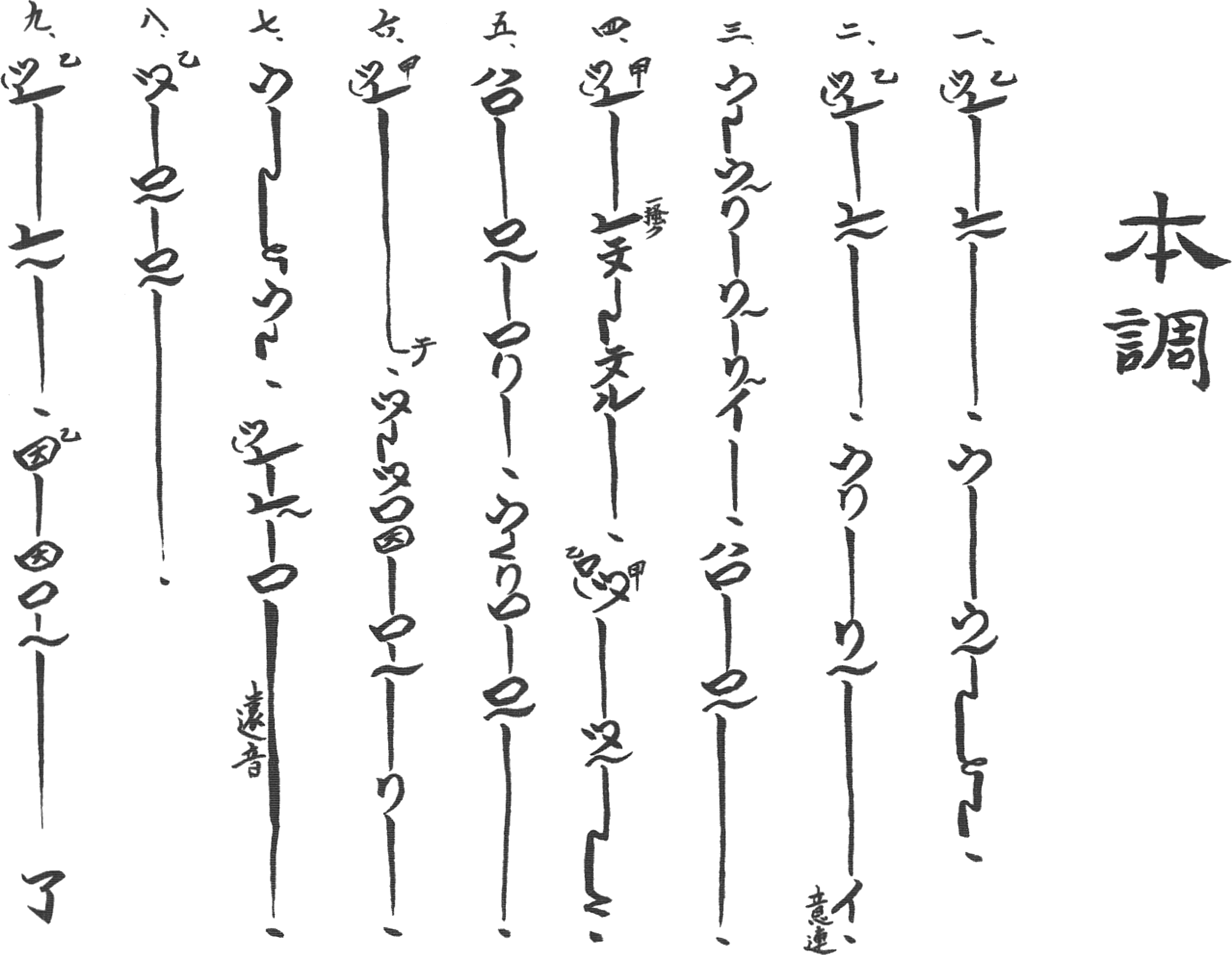
Notation ➛ fingering
- Duration?
- Pitch?
- Octave?
- Sequences (katas)?
Duration of notes
In the KSK honkyoku notation:
Lines indicate duration by their length
There is no tempo, the sound is stretched through time according to:
- the style of the school
- the mindset of the player
- the stamina and condition of the player
Sankyoku and renkan notation
Synchronization of the players requires a more precise timing
Durations in Kinko “dot” notation
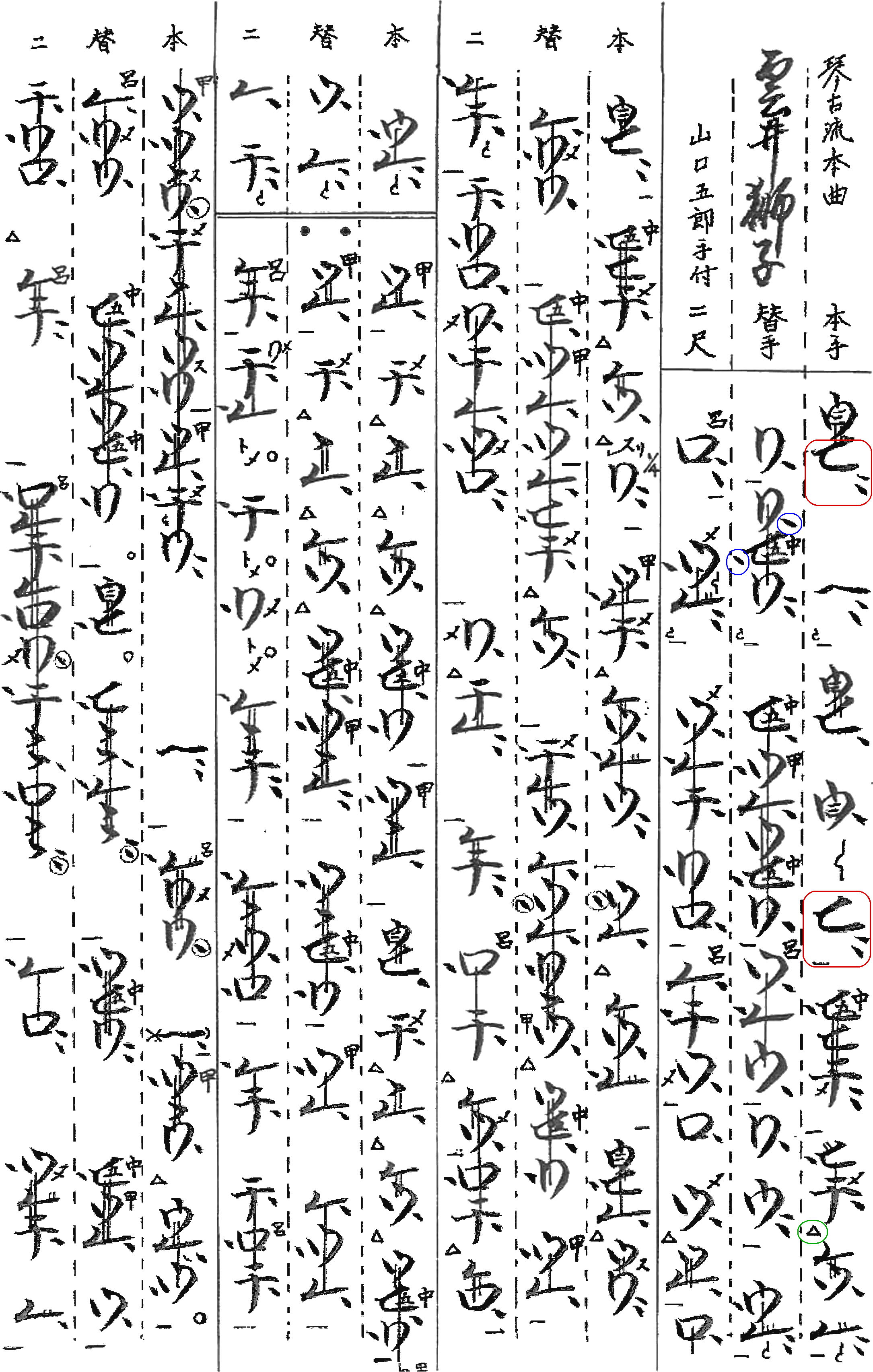
Kumoi Jishi, 3 voice version
Omote marks on the right
Ura marks on the left
Single line: twice as short notes
or grace note
Triangles indicate beats where no note starts
Notes fill in the space between marks:
the first and the third ヒ do not have the same
duration although they have two omote marks!
Durations in Kinko “dot” notation
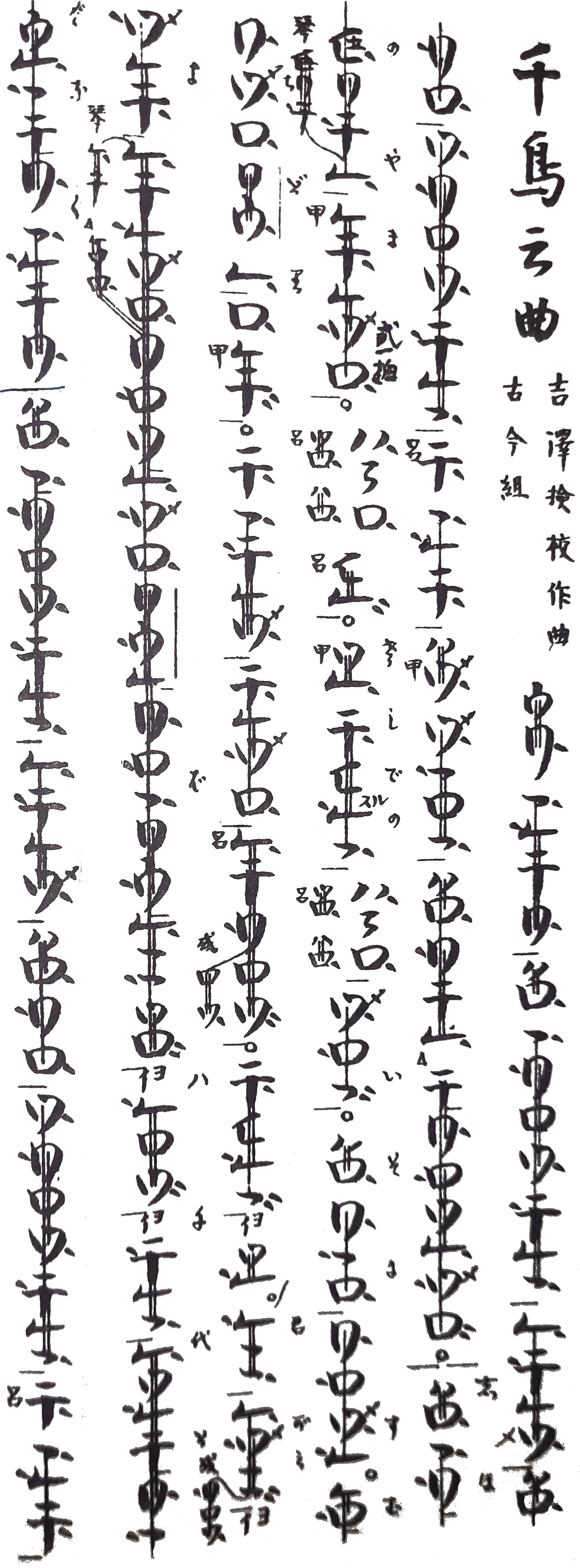
Another example: Chidori no Kyoku
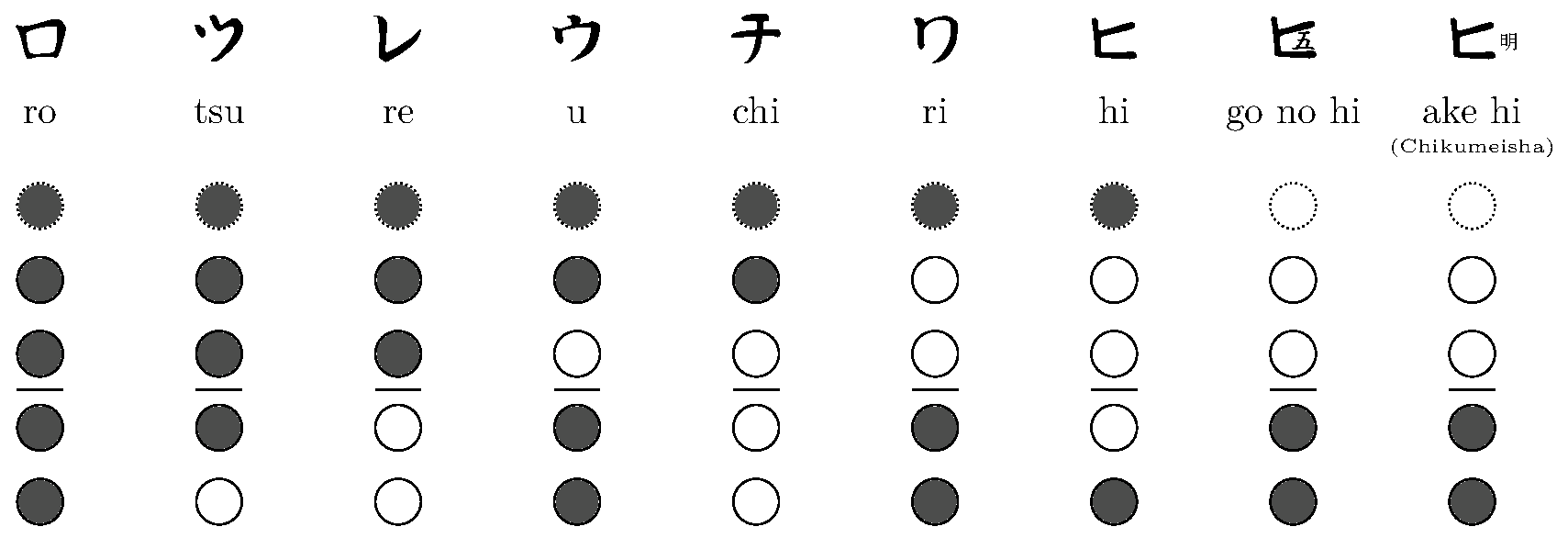

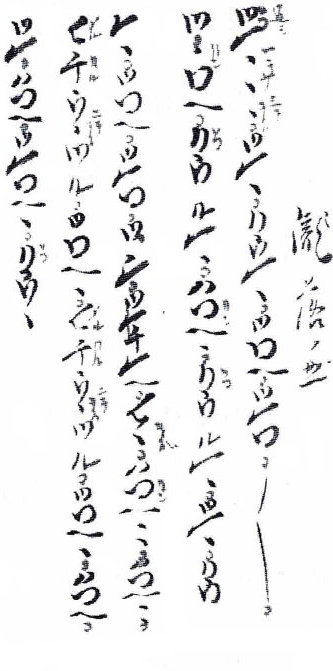


This notation of Chidori no Kyoku was written by Miura Kindō, who studied with Araki Kodo II
and Uehara Rokushirō, and published by the Chikuyūsha guild of Kinko-ryū.
It differs slightly from the notation of Araki Kodo II, III and IV.
Durations in other notations
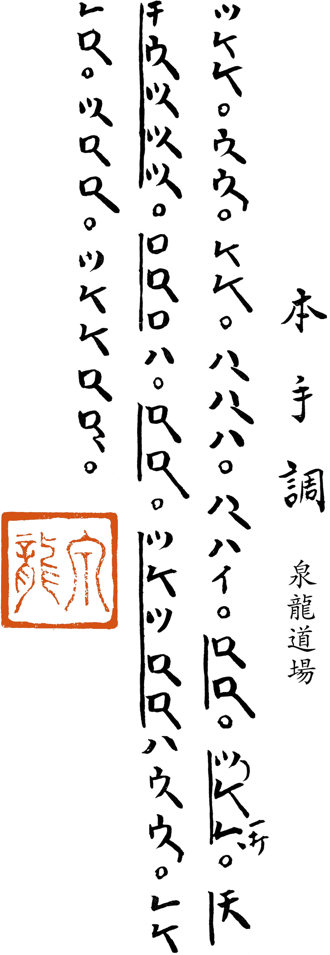
タコ足 Tako ashi
(octopus legs)
Seien Ryū

モ style
Kyū Myōan notation
モ makes the duration longer
Each mark under モ makes it even longer
A vertical line beside notes makes them shorter
Tozan notation
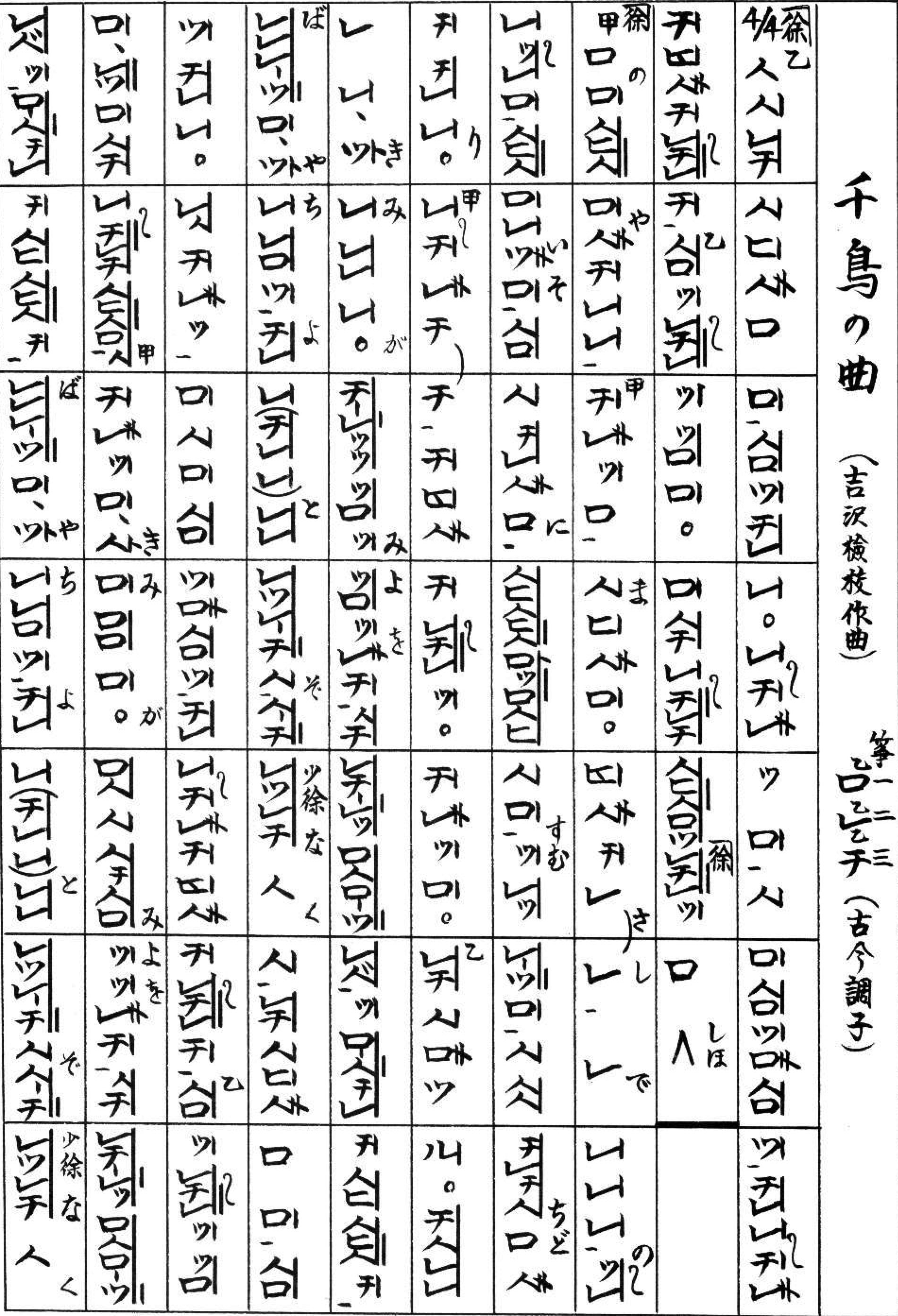
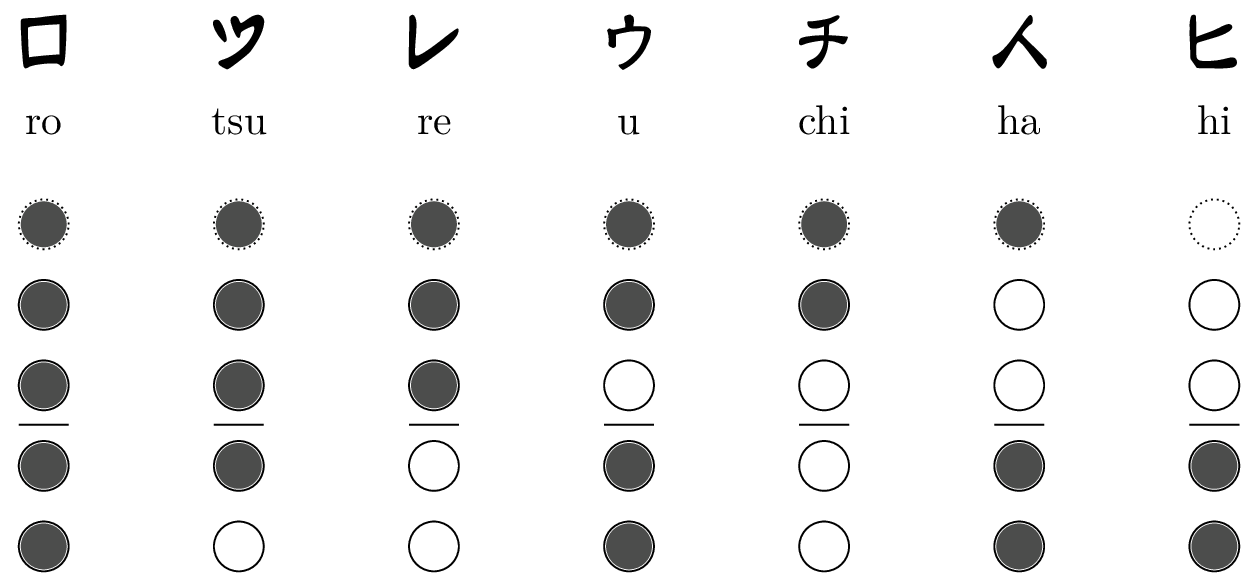
Compared to Kinko notation
- Uses ɴ (ha) instead of Ĥ (ri) and ɶ (hi)
- Uses ɶ (hi) instead of ĩ (go no hi)
Durations
- Influenced by western notation
- Time signature and bars
- Notes have a proper duration
- Rests are explicitly notated
- Side lines indicate duration
Pitch

Shakuhachi notations indicate fingering
Variations in pitch can be shown by vertical lines
or by indications such as 引き (hiki: pull)
Pitch of the “natural” notes of a 1.8 shakuhachi shown on a piano keyboard:
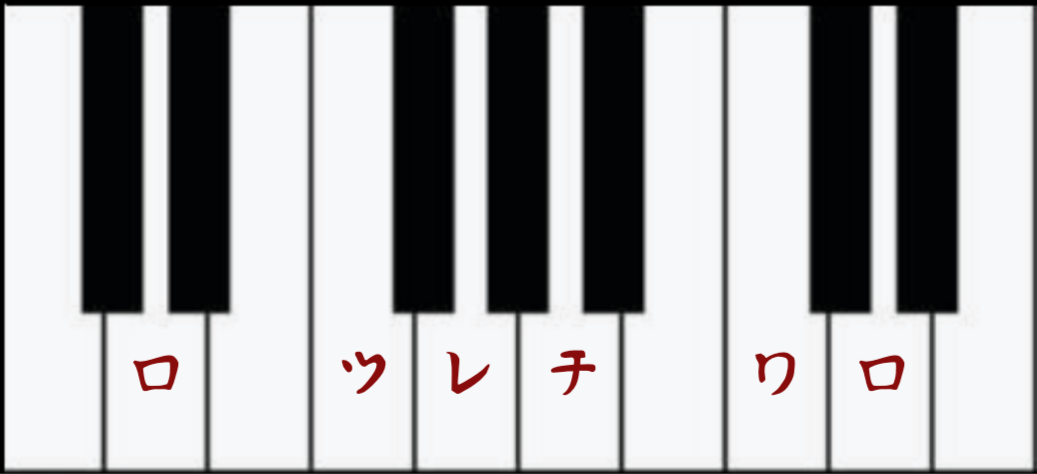
There are missing pitches...
Pitch
Meri / Kari notes
The pitch of the basic notes is changed by the meri or kari
position of the embouchure, and by partially closing holes
In Kinko notations
There are three kinds of meri: small, normal, and deep
Basically:
- chū meri (中メ) lowers the note by a half step
- meri (メ) lowers the note by a full or a half step
- dai meri (大メ) lowers the note by a full step
Examples:
- chū meri tsu ě中 is a half step below tsu ě
- tsu meri ěメ is a full step below tsu ě
However:
- chi meri Ģメ is a half step below chi Ģ
- but re meri Ğメ is generally the pitch of tsu.
- ro meri Ęメ may be a half step below ro,
with ro dai meri (or ō-meri) Ė a full step below ro
In Tozan notation
- a small note is a half step above the note below
small tsu ɨ is a half step above ro ɧ - meri (メ) lowers the note by a half step
tsu meri ɩ is a half step below tsu ɪ - small re ɬ is a half step above tsu ɪ
small re meri ʈ is the pitch of tsu ɪ
Pitch
Meri and kari notes shown on a piano keyboard
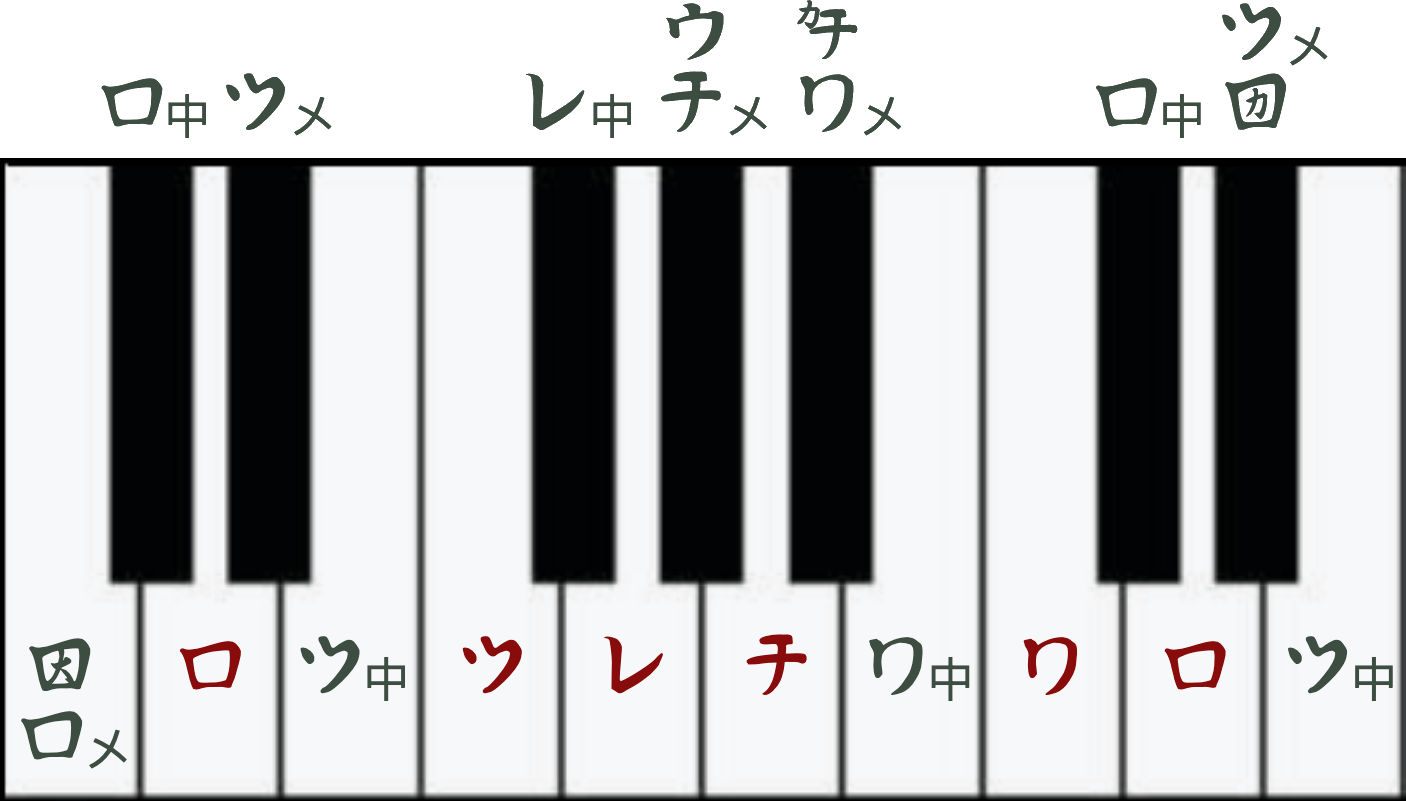
Comparing pitch variation notations
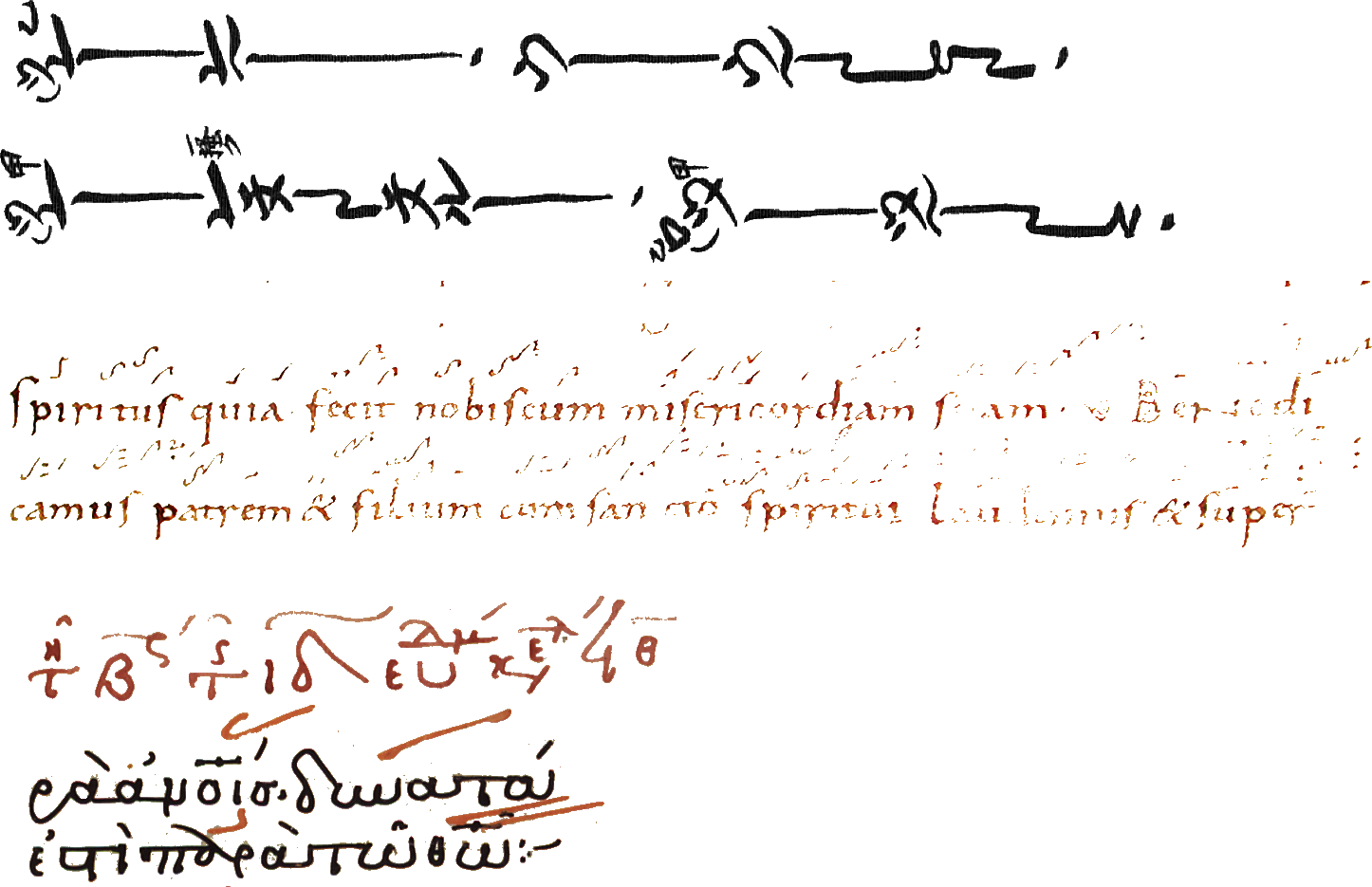
KSK / Chikushin Kai
(turned 90°)
Neumes
(Gregorian chant
in Western Europe)
Ekphonetic notation
(Gregorian chant
in Byzantium)
Octaves
- Otsu 乙 / Ryo 呂
Indicates the lower octave. Can also be indicated temporarily by a tenten: đ - Kan 甲
Indicates the second octave, you reach it by blowing with more air speed - Daikan 大甲
In this third octave, the fingerings change
Octave change rules
When you start and end in the range ri Ĥ/ha ɴ to tsu ě,
you change octave, else you stay in the same octave.
For instance
- ïĤě goes to îě
- ïĢě goes to ïě
- îĘɴ goes to ïɴ
Notations for the third octave
Kinko: a variety of ha
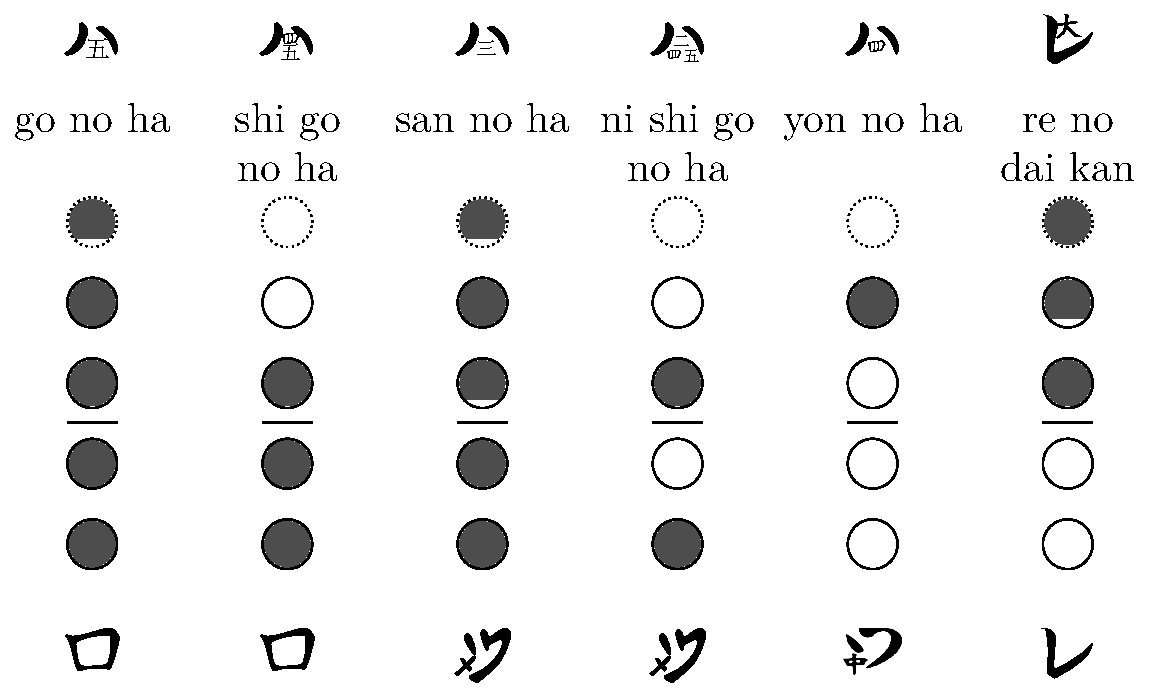
Notations for the third octave
Tozan: from pi up to the sky...

Western notation
Evolved in various monasteries for the notation of Gregorian chant
Converged towards the modern Western notation through exchanges
Western notation
Neumes for Gregorian chant (Saint Gall neumes, Xth century)
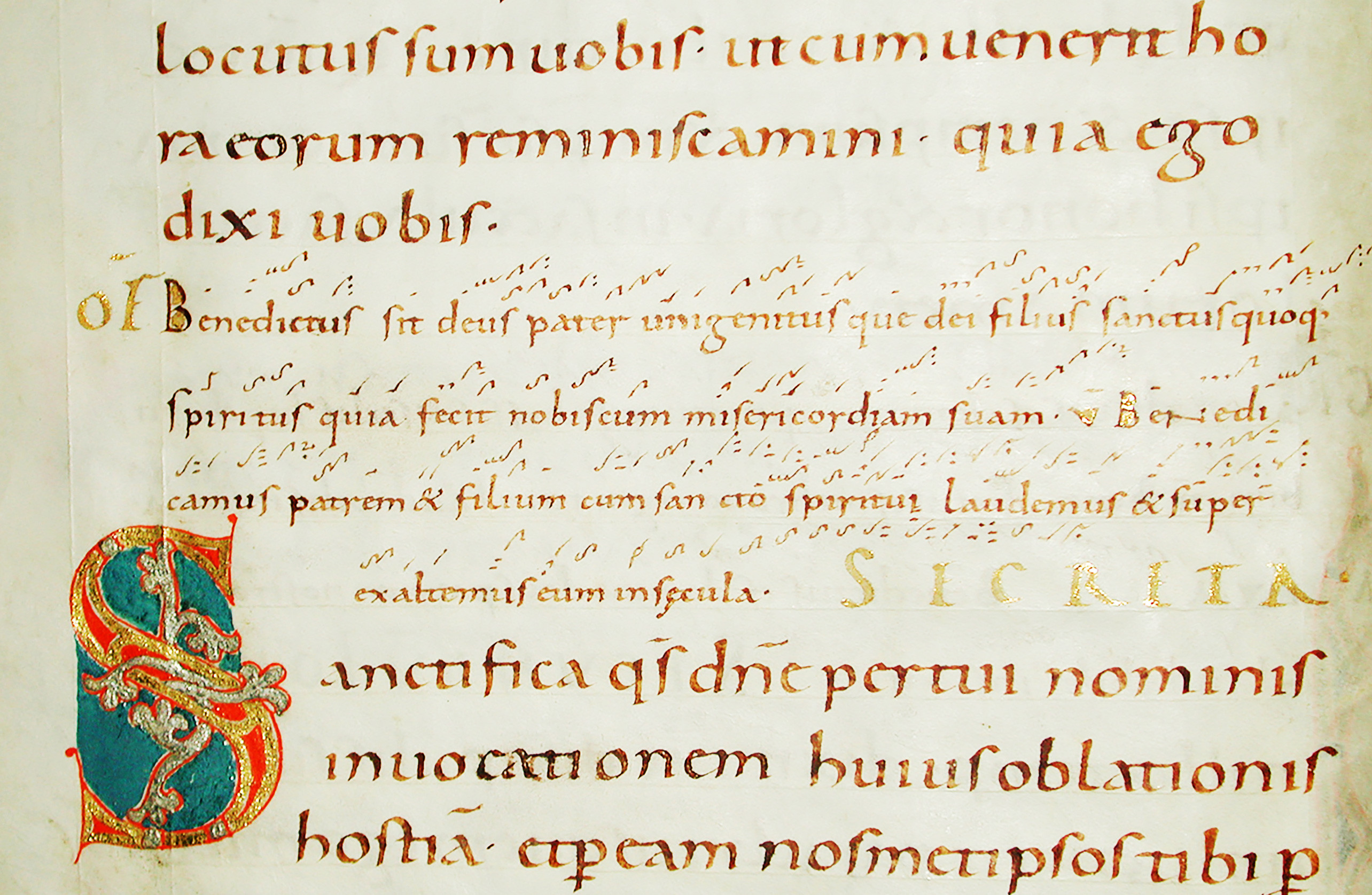
Source: French National Library
Western notation
Ekphonetic notation (Bizantium, IXth to XIVth century)
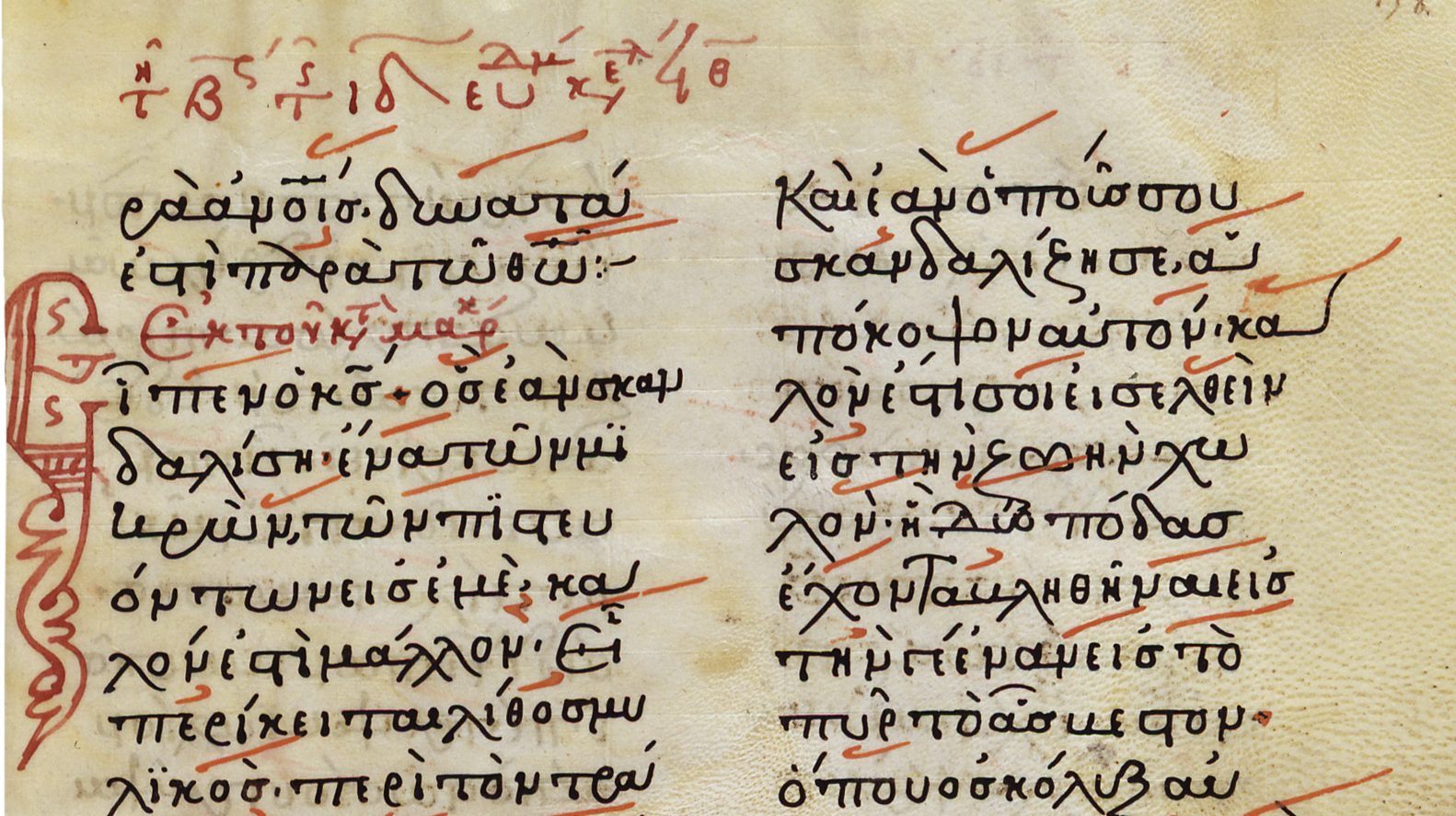
Source: French National Library
Western notation
Notations of Guido d'Arezzo (992 - 1033)

Letter notation, with its translation below

Neume notation. The red line indicates F, the green/yellow line indicates C
Source: Project Gutenberg, A Popular History of the Art of Music, by W. S. B. Mathews
Western notation
Codex Las Huelgas (~1330)
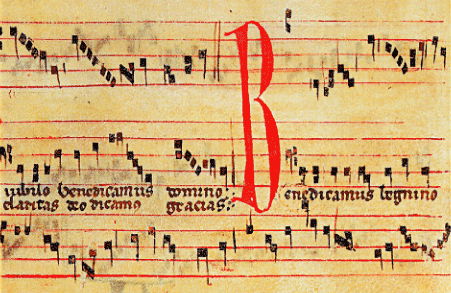
Source: Wikimedia Commons
Western notation
Collection of Italian cantata (XVIIth century)
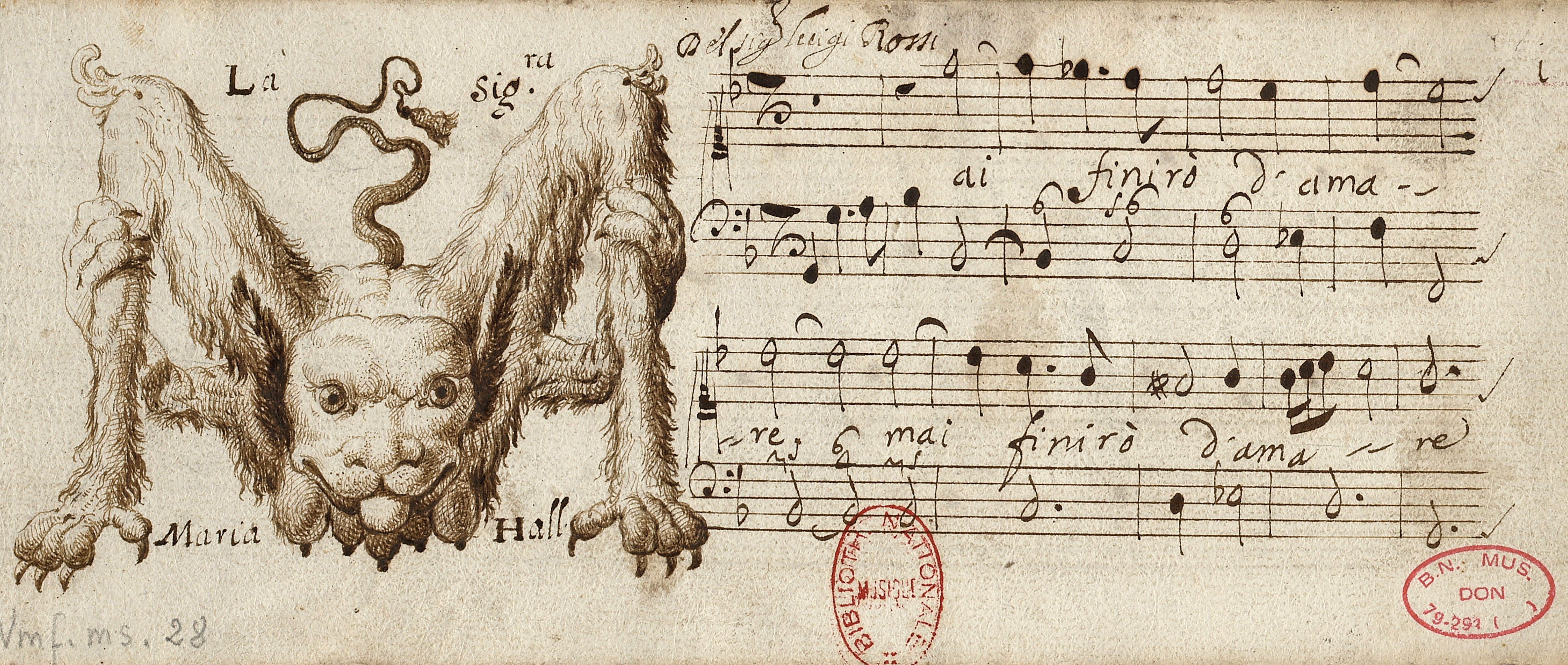
Source: French National Library
Graphical forms of notation
Toru Takemitsu
Study for Vibration
Graphical forms of notation
György Ligeti
Artikulation
Western notation
Western notation uses dots placed on a five line staff
The pitch of the notes is given by a key, we consider only the treble key here
Natural notes of a 1.8 shakuhachi:

Variations in pitch are indicated by sharps (♯), flats (♭), and naturals (♮)

Durations are indicated by the shape of the note.
Bars group units of time indicated by a time signature
Default pitch alterations are indicated by a key signature

Transposing instruments
Western notation does not always indicate pitch
Some families of instruments exist in different sizes,
so a given fingering does not yield the same pitch on all instruments
Examples
Clarinets
- The fingering of C on a “regular” clarinet yields a B flat
- The fingering of C on an A clarinet yields an A
- The fingering of C on a basset horn yields an F
- The fingering of C on a bass clarinet yields a B flat one octave lower
Saxophones
- The soprano saxophone is in B flat (the fingering of C yields a B flat)
- The “regular” alto saxophone is in E flat (the fingering of C yields an E flat)
- The tenor saxophone is in B flat
- The barytone saxophone is in E flat
Western notation for shakuhachi
In Western music vocabulary, an instrument is in X if
the fingering for C on this instrument produces the pitch of X
What is the fingering of C on a shakuhachi?
“Normal” 1.8 shakuhachi: the pitch of C is obtained with ɱ (ri)/ɴ (ha)
⇒ ɱ/ɴ is considered as the fingering of C on the shakuhachi
Therefore:
- the 1.8 shakuhachi is in C (by definition)
- the 1.6 shakuhachi is in D
- the 2.0 shakuhachi is in B flat
- the 2.4 shakuhachi is in G
Lowest note (ro)
- D on a 1.8 shakuhachi
- E on a 1.6 shakuhachi
- C on a 2.0 shakuhachi
- A on a 2.4 shakuhachi
When specifying shakuhachi pitch, it seems safer to give
both the expected pitch of ro and the length of the shakuhachi
Prefer “a 2.0 shakuhachi, ro = C” to “a B flat shakuhachi”, or “a C shakuhachi”
Chosing the right shakuhachi
for a Western notation
- Ambitus: you should be able to play all written pitches:
- Nothing too low
- Nothing too high
- Ease of play: you may avoid notes that are difficult to play
- Avoid key signatures with sharps
- Example: Ravel's Bolero
- Style: you may want that some pitch falls on a meri note
- Some tunes require a special tone color on some notes
- Example: Sakura (extract from “Japanese Tune”, a piece for wind ensemble)
Example: Ravel's boléro
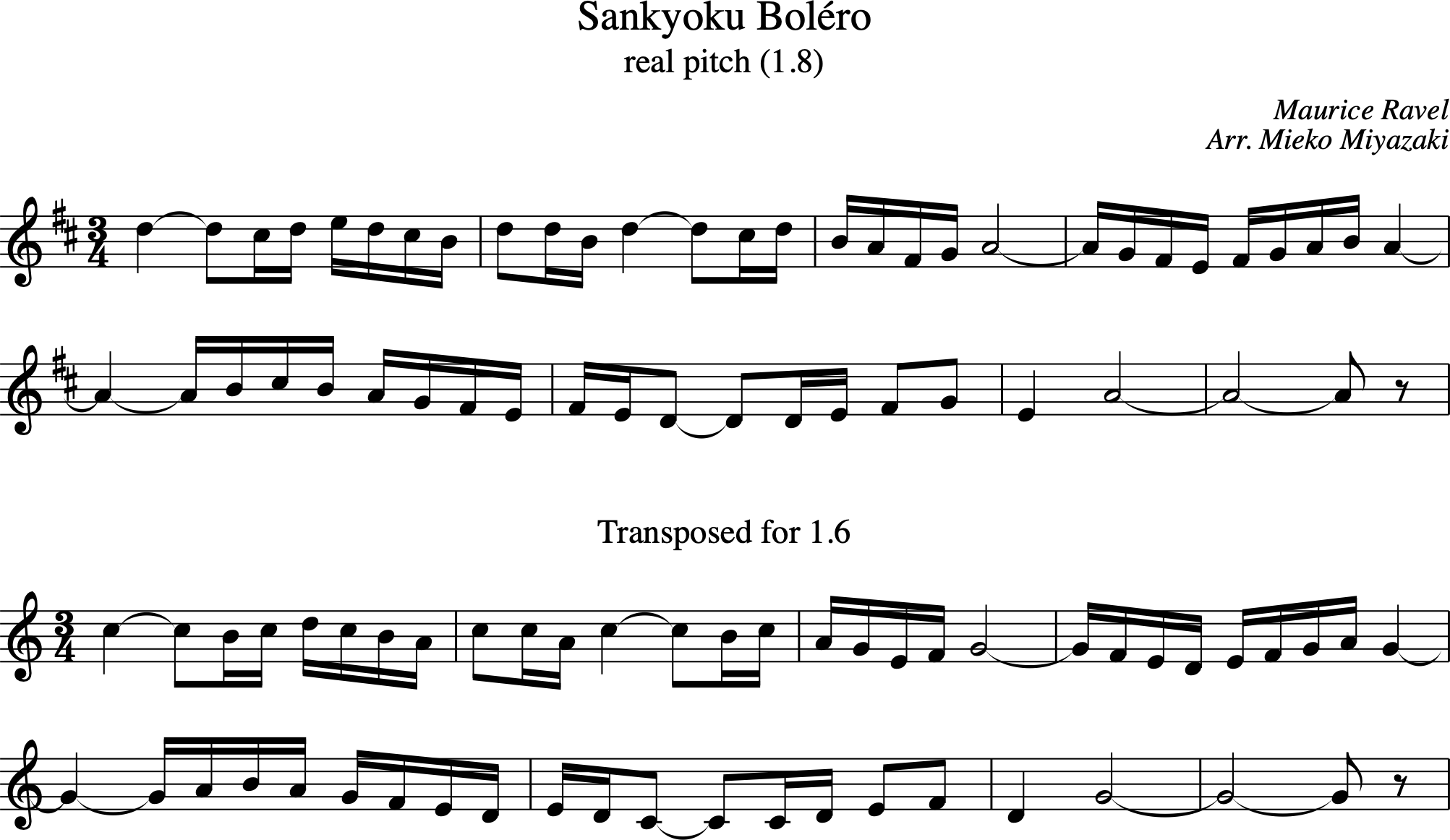
Clarinet in C
1.8 shakuhachi
1.6 shakuhachi
Example: Ravel's boléro
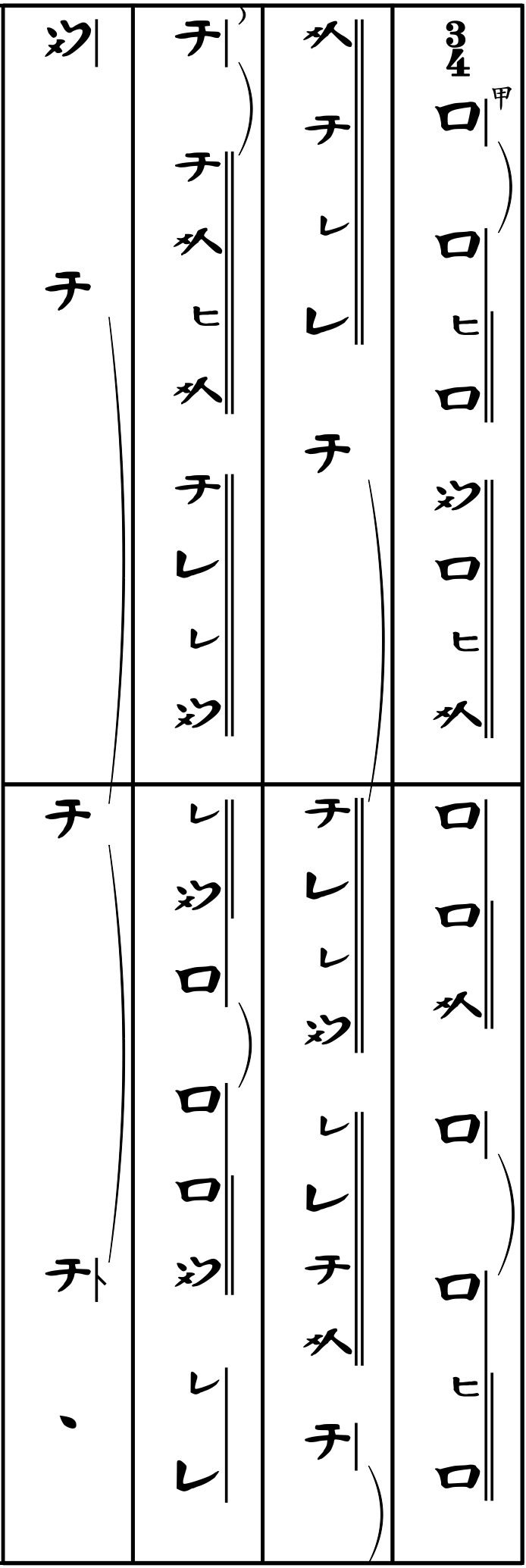 For 1.6
For 1.6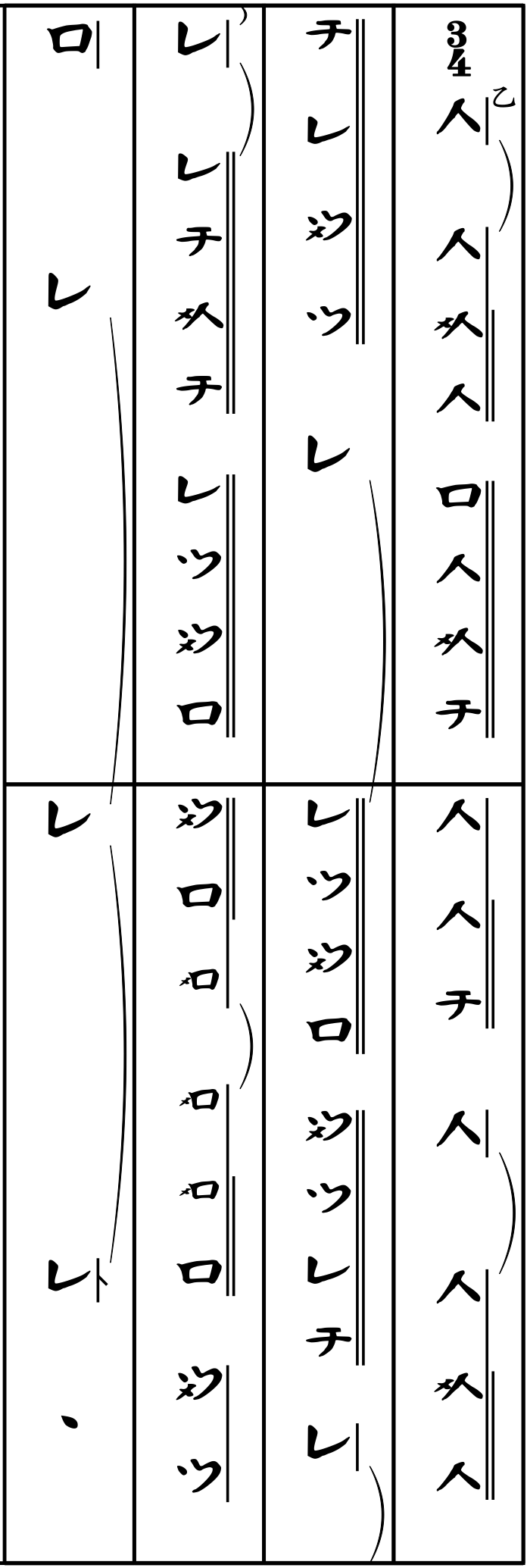
Example: Japanese Tune (Sakura)
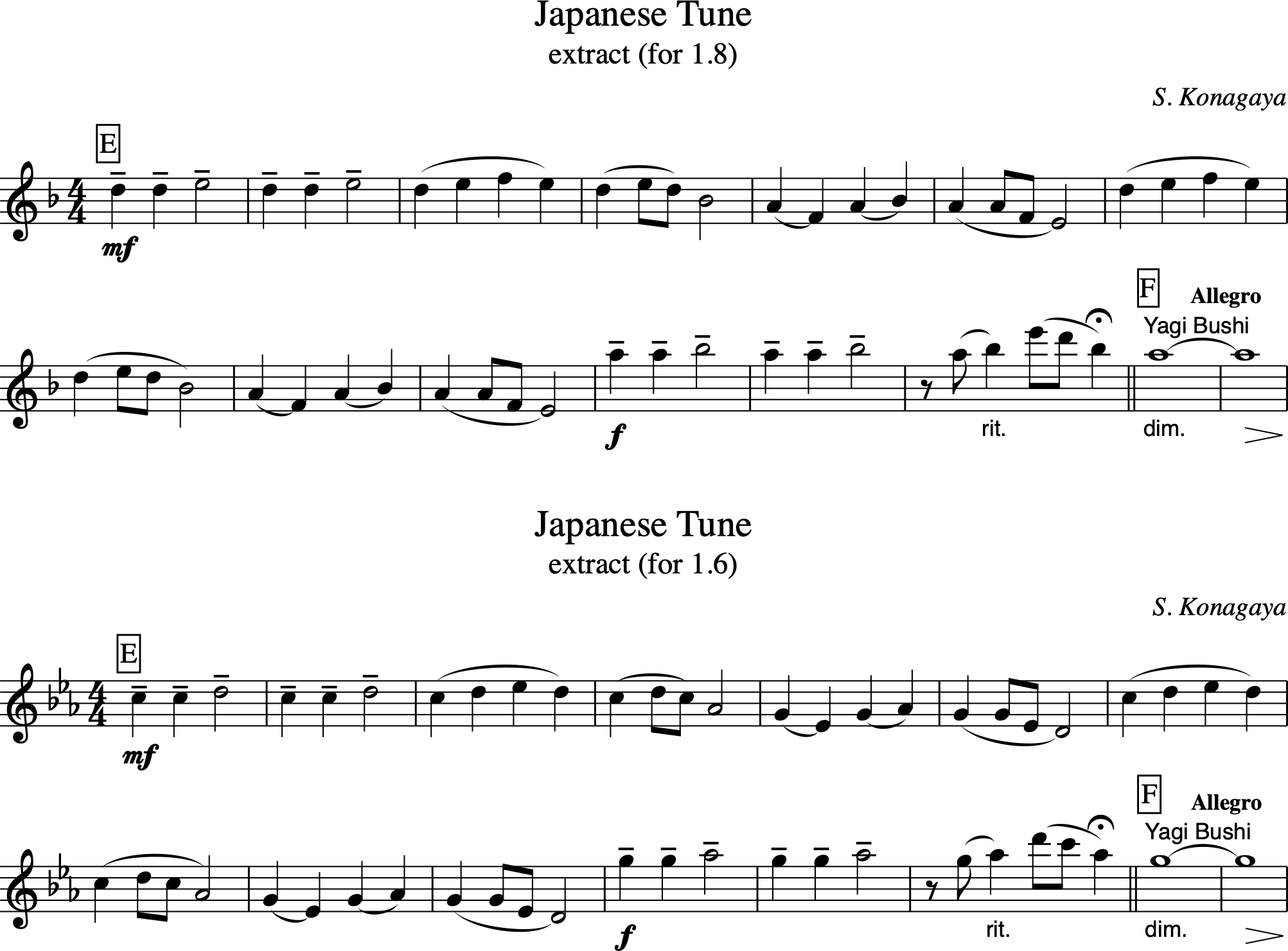
1.8 shakuhachi
1.6 shakuhachi
Shakuhachi music in Western notation
Example: Chidori no Kyoku with flute players
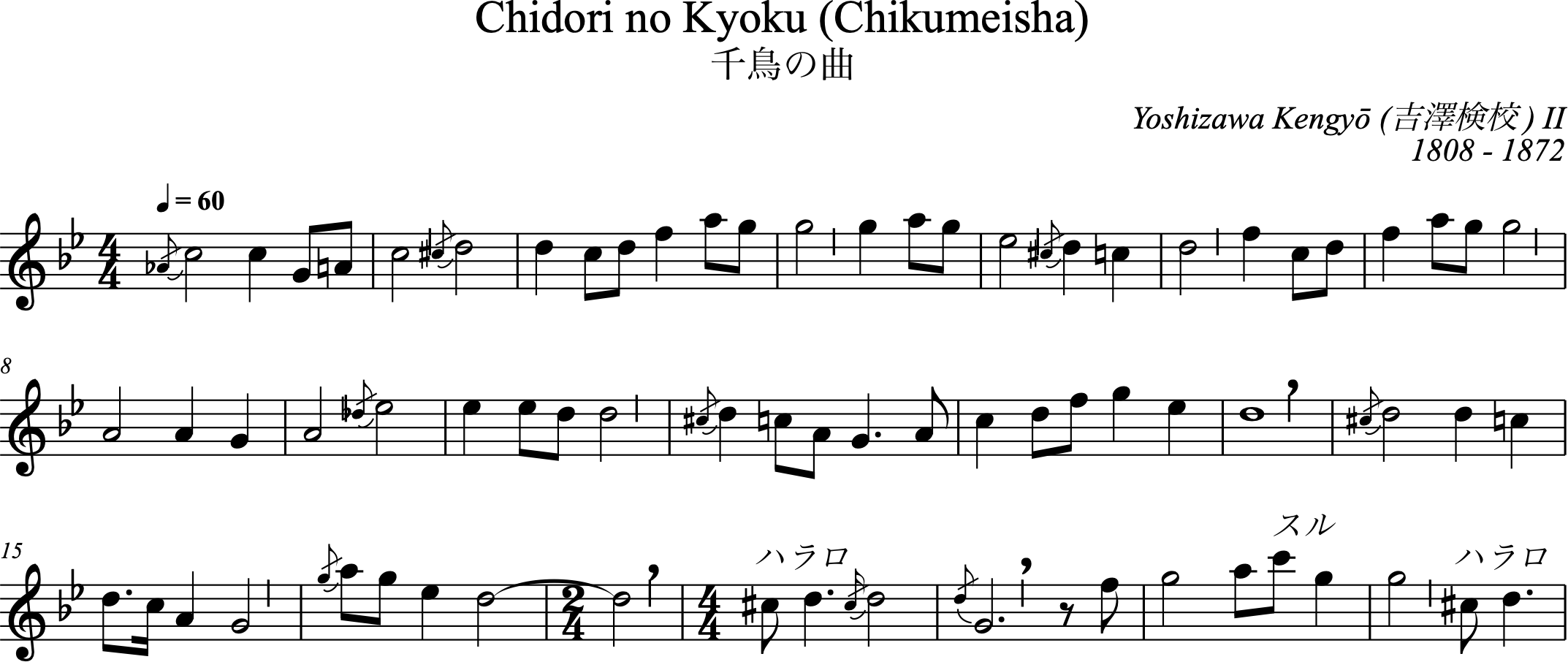
- No tonging, finger attacks
- Special articulations, suri age etc.
- Special tone color of some notes
- Beware of transposing instruments (clarinets, saxophones, trumpets)
Several flavours of Chidori no Kyoku



Conclusion
Reading a notation is not playing the style of a school
Reading several notations helps playing in various circumstances
Being able to read Western notation opens opportunities
outside the domain of traditional Japanese music
When playing Western notation:
- Consider the length of your shakuhachi
- Beware of the transposition made by the western instrument
- Take care of the range, ease of play and tone colour
Sources
Documents
- Gunnar Jinmei Linder, 2012
“Deconstructing Tradition in Japanese Music
A study of Shakuhachi, Historical Authenticity and Transmission of Tradition” - Gunnar Jinmei Linder, 2010
Notes on Kinko-ryu shakuhachi honkyoku: performance techniques – analysis, classification, explanation - Riley Kelly Lee, 1988
“Fu Ho U vs. Do Re Mi: The Technology of Notation Systems and
Implications of Change in the Shakuhachi Tradition of Japan” - Donald Paul Berger, 1969
“The Shakuhachi and the Kinko Ryū Notation” - The European Shakuhachi Society https://shakuhachisociety.eu
- The International Shakuhachi Society https://www.komuso.com
- The French National Library https://essentiels.bnf.fr
Notation
- Gunnar Jinmei Linder
- Jean-François Lagrost
- Justin Senryū
- Workshops, master-classes, summer schools...
Errors
- 100% mine
